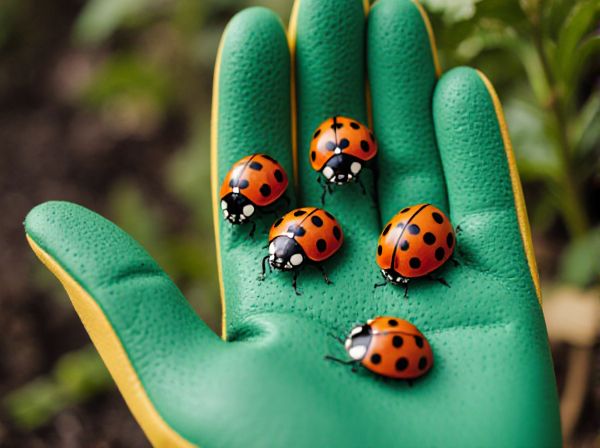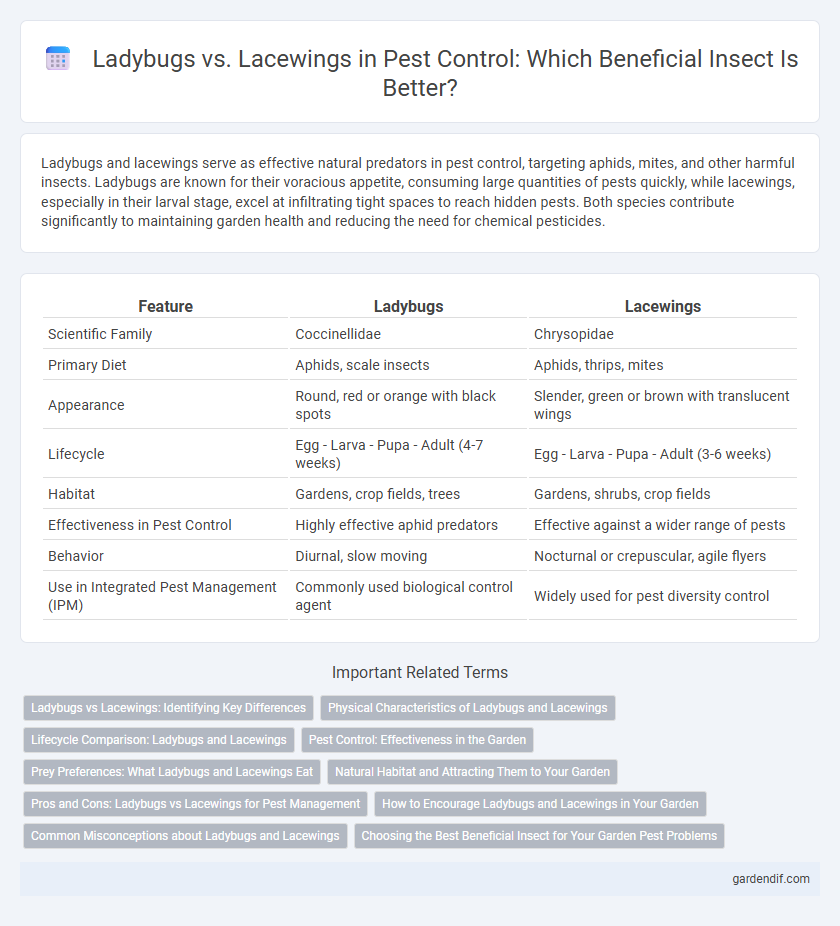
Ladybugs vs lacewings Illustration
Ladybugs and lacewings serve as effective natural predators in pest control, targeting aphids, mites, and other harmful insects. Ladybugs are known for their voracious appetite, consuming large quantities of pests quickly, while lacewings, especially in their larval stage, excel at infiltrating tight spaces to reach hidden pests. Both species contribute significantly to maintaining garden health and reducing the need for chemical pesticides.
Table of Comparison
| Feature | Ladybugs | Lacewings |
|---|---|---|
| Scientific Family | Coccinellidae | Chrysopidae |
| Primary Diet | Aphids, scale insects | Aphids, thrips, mites |
| Appearance | Round, red or orange with black spots | Slender, green or brown with translucent wings |
| Lifecycle | Egg - Larva - Pupa - Adult (4-7 weeks) | Egg - Larva - Pupa - Adult (3-6 weeks) |
| Habitat | Gardens, crop fields, trees | Gardens, shrubs, crop fields |
| Effectiveness in Pest Control | Highly effective aphid predators | Effective against a wider range of pests |
| Behavior | Diurnal, slow moving | Nocturnal or crepuscular, agile flyers |
| Use in Integrated Pest Management (IPM) | Commonly used biological control agent | Widely used for pest diversity control |
Ladybugs vs Lacewings: Identifying Key Differences
Ladybugs and lacewings are beneficial insects commonly used in pest control, with ladybugs easily recognizable by their dome-shaped, red or orange wing covers adorned with black spots. Lacewings feature delicate, translucent wings with intricate veining and a slender green or brown body. While both predators target aphids and other soft-bodied pests, ladybugs are more robust and active during the day, whereas lacewings are typically nocturnal and rely on their larvae for pest control.
Physical Characteristics of Ladybugs and Lacewings
Ladybugs possess a distinctive dome-shaped, vibrant red or orange exoskeleton with black spots, and short antennae paired with six short legs. Lacewings exhibit delicate, translucent green wings with intricate vein patterns, long slender antennae, and elongated, pale green bodies. These physical differences aid in identifying ladybugs and lacewings in various pest control environments.
Lifecycle Comparison: Ladybugs and Lacewings
Ladybugs undergo four life stages: egg, larva, pupa, and adult, completing their lifecycle in about 3 to 4 weeks. Lacewings also experience complete metamorphosis with egg, larva, pupa, and adult stages, but their development typically takes 4 to 6 weeks. Both insects' larvae are voracious predators, consuming aphids and other pests, making them vital for natural pest control throughout their lifecycles.
Pest Control: Effectiveness in the Garden
Ladybugs and lacewings are both highly effective natural predators for pest control in the garden, targeting aphids, mealybugs, and other harmful insects. Ladybugs primarily consume aphids and scale insects, quickly reducing pest populations, while lacewing larvae prey on a wider range including thrips, whiteflies, and caterpillar eggs. Utilizing a combination of both species enhances pest management by providing diverse and continuous protection across different pest infestations.
Prey Preferences: What Ladybugs and Lacewings Eat
Ladybugs primarily feed on aphids, scales, and soft-bodied insects, making them effective biological control agents in gardens and agricultural settings. Lacewings consume a broader range of prey, including aphids, mites, thrips, and insect eggs, contributing to pest population management. Both predators help reduce infestations naturally but differ slightly in prey specificity and habitat preferences.
Natural Habitat and Attracting Them to Your Garden
Ladybugs thrive in gardens rich with aphids and other soft-bodied insects, favoring flowering plants and shrubs where they can find ample food and shelter. Lacewings prefer habitats with dense vegetation and are commonly found in areas with flowering plants that produce pollen and nectar, supporting their larvae's need for prey like aphids and mites. Attract ladybugs by planting dill, fennel, and marigolds, while lacewings are drawn to yarrow, cosmos, and alyssum, enhancing your garden's natural pest control through these habitat-specific plants.
Pros and Cons: Ladybugs vs Lacewings for Pest Management
Ladybugs effectively control aphids and scale insects, with their voracious appetite making them valuable for quick pest suppression, but they may disperse rapidly, reducing long-term impact. Lacewings consume a wide variety of soft-bodied pests including aphids, thrips, and mealybugs, and their larvae are particularly voracious; however, they require specific environmental conditions to thrive and may be less effective in dry climates. Choosing between ladybugs and lacewings depends on pest type, environmental stability, and desired control duration in integrated pest management programs.
How to Encourage Ladybugs and Lacewings in Your Garden
Plant diverse flowering plants such as dill, yarrow, and fennel to attract ladybugs and lacewings by providing pollen and nectar, essential for their survival and reproduction. Maintain a chemical-free environment by avoiding pesticides and herbicides that harm these beneficial insects and disrupt their lifecycle. Introduce suitable habitats like mulched beds and ground cover, which offer shelter and breeding sites to boost natural pest control efficacy.
Common Misconceptions about Ladybugs and Lacewings
Ladybugs are often mistaken as the only beneficial insects for pest control, but lacewings play an equally vital role by preying on aphids, thrips, and whiteflies. Both ladybugs and lacewings undergo complete metamorphosis and their larvae are voracious predators, contrary to the misconception that only adult ladybugs consume pests. Misunderstanding the complementary roles of these insects leads to ineffective pest management in gardens and agricultural fields.
Choosing the Best Beneficial Insect for Your Garden Pest Problems
Ladybugs and lacewings serve as effective natural predators in garden pest management, targeting aphids, mites, and scale insects. Ladybugs primarily consume large quantities of aphids rapidly, making them ideal for immediate pest control, while lacewings excel at feeding on a broader range of soft-bodied pests, including thrips and whiteflies. Selecting the best beneficial insect depends on specific pest species present and the desired speed and range of pest suppression in your garden ecosystem.
Ladybugs vs lacewings Infographic

 gardendif.com
gardendif.com